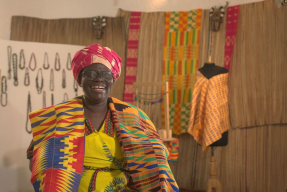By Nick Lewis, KF10 Indonesia
Ok FREEZE. What’s the first image that pops into your head when I say…….Bali.
Chances are it has very little to do with poverty and almost certainly has nothing to do with microfinance or the Kiva Fellows program. In fact, it probably doesn’t even have much to do with local Indonesians. When most people think about the “island of the gods”, as it is known in Indonesia, they picture honeymooners sipping exotic drinks while relaxing on pristine beaches, verdant rice terraces, or world-class surfers tackling some of the most famous breaks in existence. While Bali certainly deserves a place on a list of the world’s most beautiful locales, there is trouble in paradise.
I’m a somewhat unique Kiva Fellow. Technically a member of the Kiva Fellows 10th class, I trained with the 9th class and arrived in Indonesia just more than 24 hours after our last training session at the end of September. My wife and I are living in Indonesia for one year while she conducts education policy research on a Fulbright Scholarship. Having been in-country for nearly 4 months already, but without Kiva Fellows work to complete, I’ve had plenty of opportunities to act as a tourist. I’ve surfed the beaches, explored the temples, wandered the rice paddies, and eaten my fair share of babi guling. I’ve also had a unique opportunity to explore the other side of Bali, the side that very few travelers ever bother to see.
Bali is a relatively small island—approximately the same size as the US state of Delaware. Despite its small size, the vast majority of international tourists remain within a 15 mile drive of the airport in a triangle created between the towns of Kuta, Ubud and Sanur. Many opt instead for the seclusion of the gated peninsula of Nusa Dua. But there are areas of Bali that are marked by abject poverty on the same scale as the poorest communities in the world. In the foggy hillsides of Mt. Agung (Bali’s tallest volcano) there are communities in which no one travels in or out for half the year because the roads are inaccessible. Many of these villages were literally unknown to the outside world until dirt tracks were developed a few years back. There is rampant flooding during the rainy season, drought and disease during the dry season, but no one ever hears about this from their travel agent. Northwest Bali is one of the most fertile areas and is filled with agriculture ranging from rice paddies to livestock. The people of this region have the same struggles as farmers the world over, but again, their stories are rarely told.
During my stay I have explored some of these communities and I hope to explore them more as I get into the heart of my work with Mitra Usaha Kecil. While I don’t blame the tourists for relaxing during their short time on Bali, it is my hope that I can share with the world my perspective on the other side of Bali—the side not covered within the pages of Condé Nast—because this side of Bali is equally as beautiful, but is oft forgotten.
To see some of the faces of those living on ‘the other side’ of Bali, loan to Mitra Usaha Kecil.
Or, join our brand new lending team.
PREVIOUS ARTICLE
Website maintenance this Thursday →NEXT ARTICLE
Kiva.org Down Tonight @ 5 pm Pacific →














